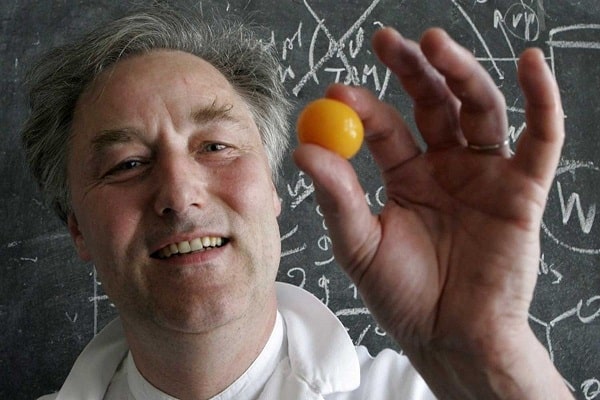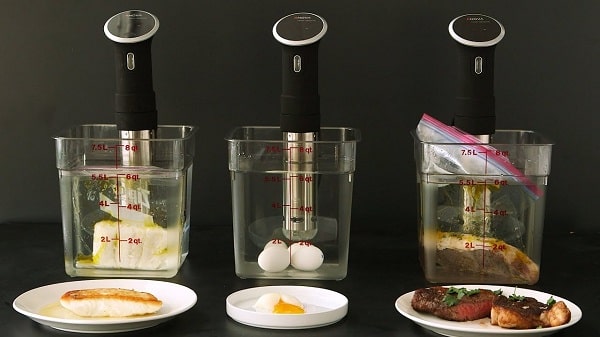Molecular cuisine is one of the most exotic and controversial modern trends in culinary art. It is hard to find a person who has never heard of it, but there are still very few people who have tried real molecular dishes in a restaurant or practice cooking them in their own kitchen. Today we will tell you what molecular cooking is, what its features are, and what its techniques are applicable at home.
History of molecular cuisine

Прародителем научного метода приготовления пищи был англо-американский ученый и изобретатель Бенджамин Томпсон, живший на рубеже 18 и 19 веков. Он внес большой вклад в изучение явлений термофизики и изобрел несколько инновационных для своего времени кухонных приборов, в частности — кухонную плиту и гейзерную кофеварку (перколятор).Бурное развитие фундаментальных и прикладных разделов физики и химии в конце 19 — начале 20 века обеспечило базу для разработки экспериментальной кулинарии, опирающейся на научные знания о молекулярном составе продуктов питания. В 1970-х усилиями британского физика венгерского происхождения Николаса Курти и французского химика Эрве Тиса, которых объединило увлечение поварским искусством, появились понятие и термин «молекулярная гастрономия». Ученые занялись изучением физических и химических изменений, происходящих во время приготовления пищи и начали изобретать новые способы создания блюд необычных форм, текстур и вкусов. «Чтобы получить новые необычные гастрономические впечатления, надо выделить соединения, ответственные за запах ингредиента, экстрагировать их водой, а затем превратить эту “еду” в желе. Такое желе можно изменить, придав ему другую текстуру или подкрасив, чтобы получить более аппетитный вид», — писал Эрве Тис.

In 1992, in Italy, Nicolas Curti and Hervé Tis held a series of seminars for scientists and practicing chefs under the general title “Molecular and Physical Gastronomy. These meetings discussed new ways of cooking and, for the first time, suggested publicly that by understanding the physical and chemical processes involved in cooking, traditional cooking techniques could be improved. In the history of world cookery there is a famous phrase of Nicholas Courty said at one of the seminars: “The problem of our civilization is that we can measure the temperature of the atmosphere of Venus, but we have no idea what is going on inside the soufflé on our table” During the practical part of the seminars scientists demonstrated how to cook meringues in a vacuum chamber, sausages using a car battery, and to make “Baked Alaska” in reverse – cold outside and hot inside – using a household microwave oven. Then Herve Ties suggested isolating a protein-dissolving enzyme from pineapple juice and using it to turn meat into liquid jelly. The participants of these scientific meetings, who embraced the philosophy of Courty and Tice, became a kind of gastronomic futurists in their desire to replace “archaic” cooking methods with a precisely calibrated scientific approach. Among them are the current stars of molecular gastronomy – Ferran Adrià, chef of the Catalan restaurant El Bulli, and the British restaurateur and chef, owner of the legendary The Fat Duck Heston Blumenthal.
By the way, the term “molecular cuisine” is not the only one, along with it in the literature you can find the terms “experimental” and “modernist”. And Ferran Adrià, who for many years cooperated with Herve Thies, prefers the term “deconstructive” or “provocative”, its main goal is to discover non-obvious links and contrasting flavors and aromas that can surprise and shock guests.
Features of molecular cuisine

Unusual shapes and flavor combinations – in a gastronomic restaurant, solid borscht, frothy Borodino bread and caviar-shaped meat can meet on the same plate.
Using special equipment different from traditional methods of cooking – convection ovens, blast chill ovens, vacuum desiccators, dehydrators, vacuum degassers, sous-vide thermostats, rotary evaporators, centrifuges, homogenizers, siphons that transform food into foam, etc.
Innovative methods and technologies. For example, chefs make products on water by adding special vegetable sugar to it, which increases the boiling point to 120 degrees. Methods of continuous low-temperature heat treatment in vacuum or instant cooling of food and dishes with liquid nitrogen are often used.
Attention to proportions – molecular cooking requires the highest accuracy, a mistake of a couple of grams can hopelessly ruin a molecular dish. That is why amateur experiments at home often fail at first.
High labor intensity and financial costs. Preparation of some dishes may take several days. In addition, the purchase of special equipment and ingredients require an impressive monetary investment. That is why dishes in gastronomic restaurants are much more expensive than traditional ones. The bill at El Bulli restaurant can be as much as €3,000 per set!
Basic techniques of molecular cuisine
Aspumulation

A common method of transforming solid and liquid foods into a stable airy foam, with all the taste properties of the product or dish retained 100%. Espumed dishes are one of the main hallmarks of molecular cooking. Surely many people have heard about molecular borscht in the form of jelly with espuma made of Borodinsky bread. Any dish made with a cremer is espuma.
Spherification and Jellification

At the heart of these essentially similar techniques is the process of turning products into gel using gelatin and sodium alginate, a viscosity-enhancing stabilizer derived from kelp algae. The well-known marmalades and jellies, as well as the artificial caviar are made using the same technology, but chefs create much more varied and perfect masterpieces – orange spaghetti, edible coffee spheres, whiskey caviar, etc.
Emulsification

The basis of this technique is the transformation of various products into a liquid emulsion consisting of water, fats and other substances. The trick is that with emulsification chefs manage to mix even insoluble substances, using soy licketyne, a natural and safe food additive. In molecular cooking emulsification is used when it is necessary to add a touch of flavor and give a delicate texture to the dish without increasing its volume. This method is used to make vinaigrette as a sauce, various mayonnaises, desserts, etc.
Vacuum technology (sous-vide)

Vacuum-packed food is subjected to a long, low-temperature treatment in water ovens or in containers heated with a thermostat, resulting in a special softness of meat, juiciness of fish, crispness of vegetables and tenderness of fruits. There are special temperature tables for selecting the optimum time and temperature for sous-vide cooking.
Low temperature method

Extreme low temperatures achieved by using liquid nitrogen and dry ice are used to make ice cream, sorbets, mousses, fudge, and other similar desserts. Liquid nitrogen is used to create unique cold mousses with a texture reminiscent of a very light, melt-in-your-mouth meringue. Dry ice is used not only for cooking, but also for spectacular serving. Baking at sub-zero temperatures is also widely used.
Transglutaminase

It consists in using transglutaminases (special enzymes capable of gluing muscle tissues) to model unusual shapes of meat or fish dishes. The Japanese first started using transglutaminases in the production of crab sticks, and then the method migrated to the kitchens of the world’s most prestigious restaurants. The famous molecular cuisine ambassador Heston Blumenthal calls transglutaminase the perfect “meat glue” without the side effects.
Is molecular cooking healthy and beneficial?
The unfamiliar names of the ingredients and food additives added to molecular dishes to produce fancy shapes, textures, flavors, and colors involuntarily suggest that this is not natural or healthy food stuffed with chemistry. However, this is nothing more than a misconception. Molecular food, like any other substance on planet Earth, is made up of chemical elements, which include natural colorings, flavor and aroma enhancers, preservatives, etc. The substances used to make molecular food are quite natural chemical compounds and natural ingredients, just to give a few examples to make sure of that.
The aforementioned sodium alginate (referred to as the E401 additive) is a completely natural, harmless substance that is derived from kelp algae. In the food industry it has been used since the 19th century to create jellies, gels, thickening liquids and stabilizing emulsions.
Calcium chloride (designated as additive E509) is a natural emulsifier and is also considered a medicinal substance to compensate for the lack of this salt in the body. Calcium chloride removes toxins from the body, relieves inflammatory and allergic reactions of the body, drugs based on it are sold in pharmacies for oral administration.
Lecithin (soybean, sunflower) is a natural substance derived from vegetable oils, its animal analogue is found in large quantities in egg yolks. Lecithin can be called without exaggeration the fuel of the human body, because its basis – phospholipids – is the building material for membranes and cells.
Liquid nitrogen, which is used to quickly freeze food and serve it in a gaseous state, is the main component of the air we breathe.
The cooking techniques also testify to the fact that molecular cooking is a healthy cuisine. An example would be dishes cooked in sous vide. Thanks to cooking in a vacuum without contact with oxygen and at low temperatures, a dish with a natural taste and appearance is obtained, while retaining most of the nutrients that are destroyed by traditional heat treatment.
Thus, there is nothing supernatural or dangerous in all the processes of molecular cooking that should be really feared, especially if we keep in mind the dominance of all kinds of “chemicals” on our tables and in everyday life in general.
